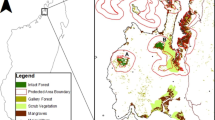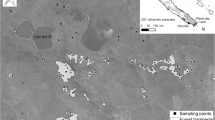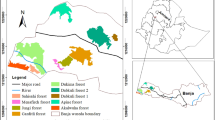Abstract
The conservation value of forest fragments remains controversial. An extensive inventory of rainforest trees in post-logging regrowth forest in the southern Philippines provided a rare opportunity to compare stem density, species richness, diversity and biotic similarity between two types of post-logging forests: broken-canopy forest fragments and adjacent tracts of closed-canopy ‘contiguous’ forest. Tree density was much lower in the fragments, but rarefied species richness was higher. ‘Hill’ numbers, computed as the exponential of Shannon’s diversity index and the inverse of Simpson’s diversity index, indicated that fragments have higher numbers of typical and dominant species compared to contiguous forest. Beta diversity (based on species incidence) and the exponential of Shannon’s diversity index was higher in fragmented forest, indicating higher spatial species turnover than in contiguous forest samples. Lower mean values of the Chao-Jaccard index in fragmented forest compared to contiguous forest also indicated a lower probability of shared species across fragments. The high species richness of contiguous forest showed that an earlier single logging event had not caused biodiversity to be degraded leaving mostly generalist species. Fragmentation and further low-level utilisation by local farmers has also not caused acute degradation. Post-logging regrowth forest fragments present a window of opportunity for conservation that may disappear in a few years as edge effects become more apparent. For the conservation of trees in forests in south-east Asia generally, our findings also suggest that while conservation of remaining primary forest may be preferable, the conservation value of post-logging regrowth forests can also be high.




Similar content being viewed by others
References
Appiah M (2013) Tree population inventory, diversity and degradation analysis of a tropical dry deciduous forest in Afram plains, Ghana. For Ecol Manag 295:145–154
Arroyo-Rodríguez V, Melo FPL, Martínez-Ramos M, Bongers F, Chazdon RL, Meave JA, Norden N, Santos B, Leal IR, Tabarelli M (2015) Multiple successional pathways in human-modified tropical landscapes: new insights from forest succession, forest fragmentation and landscape ecology research. Biol Rev. doi:10.1111/brv.12231
Arroyo-Rodŕiguez V, Rös M, Escobar F, Melo FPL, Santos BA, Tabarelli M, Chazdon R (2013) Plant β-diversity in fragmented rain forests: testing floristic homogenisation and differentiation hypotheses. J Ecol. doi:10.1111/1365.2475.12153
Ashton MS, Gunatilleke CVS, Singakumara BMP, Gunatilleke IAUN (2001) Restoration pathways for rain forest in southwest Sri Lanka: a review of concepts and models. For Ecol Manag 154:409–430
Bierregaard RO, Lovejoy TE, Kapos V, dos Santos AA, Hutchings RW (1992) The biological dynamics of tropical rainforest fragments. Bioscience 42(11):859–866
Botzag A, Fischer L, Farwig N (2015) Regeneration potential in South African forest fragments: extinction debt paid off or hampered by contemporary matrix modification? Plant Ecol 216:535–551
Bruna EM, Vascondelos HL, Heredia S (2005) The effect of habitat fragmentation on communities of mutualists: Amazonian ants and their host plants. Biol Conserv 124:209–216
Bunyan M, Shibu J, Fletcher R (2012) Edge effects in small forest fragments: why more is better. Am J Plant Sci 3(7):869–878
Cannon CH, Peart DR, Leighton M (1998) Tree species diversity in commercially logged Bornean rainforest. Science 281:1366–1388
Cayuela L, Golicher DJ, Benayas JMR, González-Espinosa M, Ramírez-Marcial N (2006) Fragmentation, disturbance and tree diversity conservation in tropical montane forests. J Appl Ecol 43(6):1172–1181
Chao A, Chazdon RL, Colwell RK, Shen TJ (2005) A new statistical approach for assessing similarity of species composition with incidence and abundance data. Ecol Lett 8:148–159
Chao A, Chiu CH, Jost L (2010) Phylogenetic diversity metrics based on Hill numbers. Philos Trans R Soc 365:3599–3609
Chiu C-H, Chao A (2014) Distance-based functional diversity measures and their decomposition: a framework based on hill numbers. PLoS One 9(7):e100014. doi:10.1371/journal.pone.0100014
Colwell RK (2013) EstimateS: statistical estimation of species richness and shared species from samples. Version 9. Users guide and application. http://purl.oclc.org/estimates. Accessed 28 March 2015
Colwell RK, Chao A, Gotelli NJ, Lin S, Mao CX, Chazdon RL, Longino JT (2012) Models and estimators linking individual-based and sample-based rarefaction, extrapolation and comparison of assemblages. J Plant Ecol 5(1):3–21
DENR (2010) Mass propagation and nursery management of dipterocarps. DENR recommends: volume 6 http://erdb.denr.gov.ph/publications/denr/denr_v6.pdf. Accessed 21 Jan 2013
Echeverría C, Newton AC, Lara A, Benayas JMR, Coomes DA (2007) Impacts of forest fragmentation on species composition and forest structure in the temperate landscape of southern Chile. Glob Ecol Biogeogr. doi:10.1111/j.1466-8238.2007.00311.x1
Edwards DP, Larsen TH, Docherty TDS, Ansell FA, Hsu WW, Derhé MA, Hamer KC, Wilcove DS (2010) Degraded lands worth protecting: the biological importance of Southeast Asia’s repeatedly logged forests. Proc R Soc B 2011:278. doi:10.1098/rspb.2010.1062
FAO (2011) Assisted natural regeneration of forests. http://www.fao.org/forestry/anr/en/. Accessed 21 Jan 2013
Fernando E, Suh M, Lee J, Lee D (2008) Forest formations of the Philippines. ASEAN-Korea Environmental Cooperation Unit (AKECU), Seoul, Korea
Gardner TA, Barlow J, Chazdon R, Ewers RM, Harvey CA, Peres CA, Sodhi NS (2009) Prospects for tropical forest biodiversity in a human-modified world. Ecol Lett 12:561–582. doi:10.1111/j.1461-0248.2009.01294
Gibson L, Lee TM, Koh LP, Brook BW, Gardner TA, Barlow J, Peres CA, Bradshaw CJA, Laurance WF, Lovejoy TE, Sodhi NS (2011) Primary forests are irreplaceable for sustaining forest biodiversity. Nature 478:378–381. doi:10.1093/jpe/rtr044
Gotelli NJ, Chao A (2013) Measuring and estimating species richness. Species diversity and biotic similarity from sampling data. In: Levin SA (ed) Encyclopedia of biodiversity, vol 5, 2nd edn. Academic Press, Waltham, pp 195–211
Hill MO (1973) Diversity and evenness: a unifying notation and its consequences. Ecology 54:427–431
IUCN (International Union for Conservation of Nature and Natural Resource) (2012). http://www.iucnredlist.org/. Accessed 15 June 2012
Jost L (2006) Entropy and diversity. Oikos 113(2):363–375
Jost L (2007) Partitioning diversity into independent alpha and beta components. Ecology 88(10):2427–2439
Jost L, DeVries P, Walla T, Greeney H, Chao A, Ricotta C (2010) Partitioning diversity for conservation analyses. Divers Distrib 16:65–76
Jost L, Chao A, Chazdon RL (2011) Chapter 6, compositional similarity and β (beta) diversity. In: Magurran AE, McGill BJ (eds) Biological diversity: frontiers in measurement and assessment. Oxford University Press, Oxford, pp 66–84
Kräuchi NA, Brang P, Schönenberger W (2000) Forests of mountainous regions: gaps in knowledge and research needs. For Ecol Manag 132:73–82
Kupfer JA, Franklin SB (2009) Linking spatial pattern and ecological responses in human-modified landscapes: the effects of deforestation and forest fragmentation on biodiversity. Geogr Compass 3(4):1331–1355. doi:10.1111/j.1749-198.2009.00245.x
Laurance WF, Laurance SG, Ferreira LV, Rankin de Merona JM, Gascon C, Lovejoy TE (1997) Biomass collapse in Amazonian forest fragments. Science 278:1117–1118
Laurance WF, Lovejoy TE, Vascolcelos HL, Bruna EM, Didham RK, Stouffer PC, Gascon C, Bierregard RO, Laurance SG, Sampaio E (2002) Ecosystem decay of forest fragments: a 22 year investigation. Conserv Biol 16(3):605–618
Leemans R (2005) The millennium ecosystem assessment: securing interactions between ecosystems, ecosystem services and human well-being. In: Chapter 3, facing global environmental change: environmental, human, energy, food, health and water security concepts. Springer, Berlin, pp 53–61
Lele N, Joshi PK, Agrawal SP (2008) Assessing forest fragmentation in northeastern region (NER) of India using landscape matrices. Ecol Ind 8:657–663
Lôbo D, Leão T, Melo FPL, Santos AMM, Tabarelli M (2011) Forest fragmentation drives Atlantic forest of northeastern Brazil to homogenisation. Divers Distrib 17:287–296
Lopez VA, Girão LC, Santos BA, Peres CA, Rabarelli M (2009) Long-term erosion of tree reproductive trait diversity in edge-dominated Atlantic forest fragments. Biol Conserv 142:1154–1165
MacArthur RH (1965) patterns of species diversity. Biol Rev 40:510–533. doi:10.1111/j.1469-185x.1965.rb00815.x
Magurran AE, McGill BJ (2011) Biological diversity: frontiers in measurement and assessment. Oxford University Press, Oxford. 345
Marcon E, Scotti I, Hérault B, Rossi V, Lang G (2014) Generalisation of the partitioning of Shannon diversity. PLoS One 9(3):1–8
Maurer BA, McGill BJ (2011) Measurement of species diversity. Chapter 5, compositional similarity and β (beta) diversity. In: Magurran AE, McGill BJ (eds) Biological diversity: frontiers in measurement and assessment. Oxford University Press, Oxford, pp 55–66
McNamara S, Erskine PD, Lamb D, Chantalangsy L, Boyle S (2012) Primary tree species diversity in secondary fallow forests of Laos. For Ecol Manag 281:93–99
Pimm SL (1998) Ecology: the forest fragment classic. Nature 393:23–24. doi:10.1038/29892
Schleuning M, Farwig N, Peters MK, Bergsdorf T, Bleher B, Brandl R, Dalitz H, Fischer G, Freund W, Gikungu MW, Hagen M, Garcia FH, Kagezi GH, Kaib M, Kraemer M, Lung T, Naumann CM, Schaab G, Templin T, Uster D, Wägele W, Böhning-Gaese K (2011) Forest fragmentation and selective logging have inconsistent effects on multiple animal-mediated ecosystem processes in a tropical forest. PLoS One 6(11):e27785
Streubig MJ, Kingston T, Zubaid A, Mohd-Adnan A (2008) Conservation value of forest fragments to Palaeotropical bats. Biol Conserv 141:2112–2126
Swaine MD, Whitmore TC (1988) On the definition of ecological species groups in tropical rain forests. Vegetation 75:81–86
Turner IM (1996) Species loss in fragments of tropical rain forest: a review of evidence. J Appl Ecol 33:200–209
Villard MA, Metzger JP (2014) Beyond the fragmentation debate: a conceptual model to predict when habitat configuration really matters. J Appl Ecol 51:309–318. doi:10.1111/1365-2664.12190
Warburton T (2009) The Philippine owl conservation programme: why is it needed? Ardea 97(4):429–438
Acknowledgments
The authors would like to acknowledge our use of EstimateS software provided as a free internet download by Rober K. Colwell of the University of Connecticut. The assistance of Mr. Nelson Quilario in identifying tree species is also gratefully acknowledged.
Author information
Authors and Affiliations
Corresponding author
Additional information
Communicated by Peter Ashton.
Appendices
Appendix 1: Background to estimating metrics of diversity
Metrics of species diversity have been extensively discussed in the recent literature, (e.g. see Jost 2006, 2007; Marcon et al. 2014; Chao et al. 2010; Magurran and McGill (2011); Chiu and Chao 2014). In particular, Jost et al. (2011) and Gotelli and Chao (2013) provided a comprehensive description of how diversity metrics are calculated. We present a brief description of the key metrics used in this research.
Species richness
Species richness is the total number of different species in an assemblage and is thus a key ecological attribute of an assemblage. However, unless the entire assemblage is inventoried, observed species richness is always an underestimate of true species richness, because increasing the number of samples increases the likelihood of adding new rare species. Species richness does not take into account levels of species abundance; thus rare and common species are not distinguished.
Within an assemblage, the observed numbers of species depend upon the area sampled and the number of individuals sampled. For sample-based data, species richness is often depicted in a species accumulation curve which shows the cumulative number of individuals or sampling units on the x axis and cumulative species richness on the y axis). Typical species accumulation curves rise rapidly at first, as common species are encountered and then rise more slowly as rare species are eventually inventoried, the curve eventually becoming asymptotic. The curves are often calculated using rarefaction, a resampling and interpolation technique, in which individuals or sampling units are selected at random from the entire sampling assemblage until all individuals and species have all been accumulated. The resampling process is repeated many times and mean species richness and other diversity indices are calculated for each level of accumulation. This results in a smoothed species accumulation curve which may be extrapolated. Extrapolation should not be extended more than double the reference sample’s size because variance may become very large (Colwell et al. 2012; Gotelli and Chao 2013). Alternatively, species accumulation curves of two (or more) datasets of different size, may be compared by scaling back the cumulative number of individuals in the larger dataset to the same number of individuals or sampling units of the smaller dataset.
Species diversity indices
Species diversity is a function of species richness and the relative abundance (evenness) of species in an assemblage (Maurer and McGill 2011). Two popular diversity indices are Shannon’s entropy (H) and the Gini-Simpson (D) diversity indices, calculated as:
where ‘s’ is the number of species in the assemblage and ‘p i ’ is the population frequency of the ith species.
Shannon entropy quantifies the uncertainty of the species identity of a randomly chosen individual in the assemblage and the Gini–Simpson index measures the probability that two randomly chosen individuals (selected with replacement) belong to two different species. In their ‘raw’ form, these diversity indices calculate entropy i.e. the uncertainty of the species identity of a sample, not diversity itself and they are non-linear with respect to increasing diversity (Jost 2006; Chao et al. 2010). In certain circumstances, the indices can be misleading as they do not provide a measure based on numbers of species (e.g. see Chao et al. 2010). Hence, following the work of MacArthur (1965) and Hill (1973) these raw diversity metrics are often converted into ‘Hill’ numbers, which provide a measure of the equivalent number of equally abundant species.
Hill numbers (qD) are calculated according to their order, ‘q’ which determines their sensitivity to species relative abundance. When q = 0, 0D is equal to species richness, when q = 1, the Hill number 1D is the exponential form of Shannon entropy which weights species according to their frequency and can be approximately expressed as the number of typical species in the assemblage. When q = 2, the Hill number 2D is the inverse of the Gini-Simpson entropy and is heavily weighted towards very common or dominant species in the assemblage.
Decomposition into alpha (α), beta (β) and gamma (γ) diversity components
Spatially, tropical forests typically have high rates of species turnover, i.e. compositional similarity is low (Arroyo-Rodriguez et al. 2013). Hence, ecologists often wish to compare the diversity of a sub-assemblage to the diversity of the overall assemblage. If weighted appropriately, sample data may be pooled and diversity may be calculated as an overall assemblage diversity (gamma, γ), within or sub-assemblage diversity (alpha, α), and between-group (beta, β) diversity.
Recent debate concerning the most appropriate way to partition gamma diversity into alpha and beta diversity has resulted in consensus that when considering diversity in terms of Hill numbers, the relationship between gamma, alpha and beta diversity is multiplicative, rather than additive i.e., gamma = beta × alpha or Dγ = Dβ × Dα (see Jost 2007; Jost et al. 2010; Marcon et al. 2014). Beta diversity is then calculated as the ratio of gamma to mean alpha diversity and may be interpreted as the effective number of distinct communities in an assemblage (Jost 2007). In general, high beta diversity implies that alpha is much less than gamma diversity and that species turnover between the sub-assemblage and the assemblage is high.
Alpha, gamma and hence beta diversity for q = 0 (species richness) and q = 1 (exponential form of Shannon entropy) may be calculated using equations presented by Jost et al. (2011), i.e.
Biotic similarity
Whereas beta diversity describes the turnover of species from a sub-assemblage to the overall assemblage, indices of biotic similarity enable comparison of species shared by two assemblages. The comparison may be between two different assemblages or between a sub-assemblage and the combined assemblage. For this purpose the Jaccard index compares the number of shared species in an assemblage (i.e. a sample) to the total number of species in the combined assemblages. The Chao-Jaccard index considers the probability that two individuals (one each drawn from both assemblages) belong to any shared species, not necessarily the same shared species. The index has a maximum value of one when all species are shared and a minimum value of zero when no species are shared (Jost et al. 2011; Gotelli and Chao 2013).
Appendix 2
See Table 4.
Rights and permissions
About this article
Cite this article
Baynes, J., Herbohn, J., Chazdon, R.L. et al. Effects of fragmentation and landscape variation on tree diversity in post-logging regrowth forests of the Southern Philippines. Biodivers Conserv 25, 923–941 (2016). https://doi.org/10.1007/s10531-016-1098-6
Received:
Revised:
Accepted:
Published:
Issue Date:
DOI: https://doi.org/10.1007/s10531-016-1098-6




